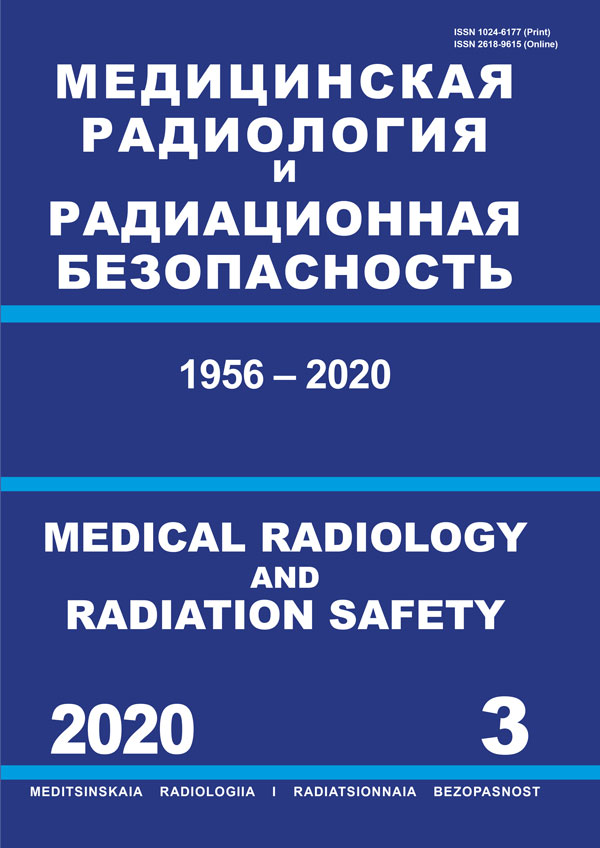Russian Federation
Russian Federation
Russian Federation
Russian Federation
Russian Federation
Russian Federation
CSCSTI 76.03
CSCSTI 76.33
Russian Classification of Professions by Education 14.04.02
Russian Classification of Professions by Education 31.06.2001
Russian Classification of Professions by Education 31.08.08
Russian Classification of Professions by Education 32.08.12
Russian Library and Bibliographic Classification 51
Russian Library and Bibliographic Classification 534
Russian Trade and Bibliographic Classification 5708
Russian Trade and Bibliographic Classification 5712
Russian Trade and Bibliographic Classification 5734
Russian Trade and Bibliographic Classification 6212
Purpose: To study the possibility of malignant transformation of control and irradiated mesenchymal stromal stem cells (MSC) from the bone marrow (BM) and brain (BR) and from the adipose tissue (AT) of mice and some cytokines secretion after mixed γ,neutron (γ, n) irradiation and γ-irradiation. Material and methods: MSCs were isolated and cultured according to generally accepted protocols. γ, n-irradiation was carried out by a collimated beam of neutrons and gamma rays at a special station of the nuclear reactor IR-8. MSCs were irradiated at the 29th passage at doses of 0.05; 0.5 and 2 Gy, were cultured for 10 passages and transplanted subcutaneously 1×106 cells to C57BL/6 syngeneic mice. MSCs AT were irradiated at the facility GUT-200M (60Co) at doses 1–6 Gy. The level of cytokines in the culture medium of MSC was measured by an ELISA. Results: A decrease in RBE was observed after radiation dose increasing from 0.5 to 4.0 Gy. The maximum of RBE for all MSCs, equal to 5.5, was observed at a dose of 0.5 Gy. After the dose increasing to 2 Gy an average RBE decreased to 2.5, and at dose 4.0 Gy RBE it was 2.0. Tumors were detected after 5 months after transplantation into syngeneic mice of MSC BM irradiated at doses of 0.05; 0.5 and 2 Gy. After transplantation of control MSCs BM and of control and irradiated MSCs BR and MSC AT, no tumors were detected. After subcutaneous injection of γ-irradiated at doses of 0.1; 1 and 6 Gy MSC AT, unlike MSCs BM, no tumors were detected. Histological examination of tumors revealed signs of a low-grade fibrosarcoma with active proliferation and a high degree of malignancy. Tumors contained inclusions from the derivatives of several tissues of mesenchymal origin – muscular, fatty, cartilaginous and bone. In the case of a tumor that developed after transplantation of MSCs BM exposed to γ,n-radiation at a dose of 0.05 Gy, the contact metastasis was detected in the shoulder with the penetration of tumor cells between the muscle fibers. From the tumors, the mouse fibrosarcoma cell lines were obtained. The highest level of cytokines VEGF, HGF and IL6was found in the culture medium of MSC AT. The level of TGFβ secretion was practically the same in all studied MSCs. After γ,n-irradiation an increase of VEGF secretion in MSC BM, a decrease of IL6 secretion in MSC BM and MSC BR, and an increase in its secretion in MSC AT were detected. Conclusions: The obtained results testify the high sensitivity of MSC BM to malignant transformation after ionizing irradiation and the much higher resistance of mouse MSC BR and MSC AT. The mechanisms of these differences are yet not known. The highest level of cytokines VEGF, HGF and IL6 was found in the culture medium of MSC AT. After the action of γ,n-radiation, as well as after the action of γ-radiation, the secretion profile of the investigated cytokines was changed, depending both on the dose and on the type of radiation.
mesenchymal stem cells, malignant transformation, carcinogenesis, γ-irradiation, γ,n-irradiation, neutrons, bone marrow, brain, adipose tissue, cytokines, mice
1. Zacharatou Jarlskog C, Paganetti H. Risk of developing second cancer from neutron dose in proton therapy as function of field characteristics, organ, and patient age. Int J Radiat Oncol Biol Phys. 2008;72(1):228-35. DOI:https://doi.org/10.1016/j.ijrobp.2008.04.069.
2. Musabaeva LI, Golovkov VM. Fast Neutron Therapy for Cancer Patients. Siberian Journal of Oncology. 2015;2:88-94. (Russian.)
3. Taddei PJ, Mirkovic D, Fontenot JD, Giebeler A, Zheng Y, Kornguth D, Mohan R, Newhauser WD. Stray radiation dose and second cancer risk for a pediatric patient receiving craniospinal irradiation with proton beams. Phys Med Biol. 2009 Apr 21;54(8):2259-75. DOI:https://doi.org/10.1088/0031-9155/54/8/001.
4. Newhauser WD, Durante M. Assessing the risk of second malignancies after modern radiotherapy. Nat Rev Cancer. 2011;11(6):438-48. DOI:https://doi.org/10.1038/nrc3069.
5. Stem Cell Biology with Respect to Carcinogenesis Aspects of Radiological Protection. ICRP Publication 131. Ann. ICRP 44(3/4): 7-357. DOI:https://doi.org/10.1177/0146645315595585.
6. Moskaleva EYu, Semochkina YuP, Rodina AV, Chukalova AA, Posypanova GA. Effects of γ-Radiation on Mesenchymal Stem Cells from Mouse Bone Marrow and Brain and Their Ability to Induce Tumors. Radiat Biol Radioecol. 2017;57(3):245-56. (Russian.)
7. Moskaleva EYu, Zhorova ES, Semochkina YuP, et al. Characteristics of Tumors That Have Developed in Mice Injected with Syngenic Irradiated Mesenchymal Stem Cells of Bone Marrow. Cell and Tissue Biology, 2017;11(5):381-8.
8. Zuk PA, Zhu M, Mizuno H, et al. Multilineage cells from human adipose tissue: implications for cell-based therapies // Tissue Eng. 2001;7(2):211-28. DOIhttps://doi.org/10.1089/107632701300062859.
9. Arzumanov SS, Safronov VV, Strepetov AN. Determination of the absorbed dose in a biological sample after mixed gamma-neutron irradiation. J. Techn. Physics. 2018;88(10):1581-4.
10. Maleta YuS, Tarasov VV. Non-parametric methods of statistical analysis in biology and medicine. Moscow. MSU. 1982. (Russian.)
11. Wolf C, Lafuma J, Masse R, Morin M, Kellerer AM. Neutron RBE for induction of tumors with high lethality in Sprague-Dawley rats. Radiat Res. 2000;154(4):412-20.
12. Broerse JJ, van Bekkum DW, Zoetelief J, Zurcher C. Relative biological effectiveness for neutron carcinogenesis in monkeys and rats. Radiat Res. 1991;128(1 Suppl):S128-35.
13. Kamiya K, Inoh A, Fujii Y, Kanda K, Kobayashi T, Yokoro K. High mammary carcinogenicity of neutron irradiation in rats and its promotion by prolactin. Jpn J Cancer Res. 1985;76(6):449-56.





